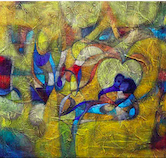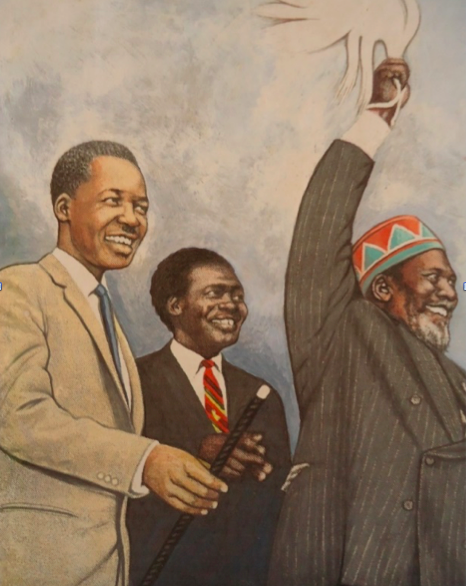The Ethiopian Orthodox Tewahedo Church has had a pivotal influence, not only in encouraging a tradition of making art, but also on the art education history of Ethiopia. One of the earliest institutionalized attempts to provide art education on record was by the church, even though the undertaking was based on the church’s doctrine. Another effort, though less documented, was by pre-modern artists who educated talented and interested students in artistic production. These artists, who mostly were self-taught, had exposure to artistic canons through the church initially and later on began to produce art in a style usually referred to as “Ethiopian traditional art.”
The style annotates folklores that relate to history, life styles and norms prevalent in some societies of Ethiopia. “Ethiopian traditional Art” emerged during the last decades of the 19th century, continued throughout the modern art history of Ethiopia and is still practiced by some. Scholars like Dr. Mulugeta Tafesse mention that this training, which can be considered informal, used to be provided in the same location where the Addis Ababa Fine Art School – the present day Alle School of Fine Arts and Design – was established and is currently located in1. There is a significant number of these artworks in the collection of the Alle School of Fine Arts and Design, which attests to the existence of this informal training based on the so called “Ethiopian traditional Art” as located in or around the school’s premises. These artworks are similar in subject matter and style of painting, and are often not dated. They were mostly created during the 1940s and early 1950s, prior to the establishment of the school. A few works from the collection are presented below. The effort to form an art school was also made by Agegnehu Engida, one of the earliest modernists. It was in the mid-1940s, while working as the deputy director of the Department of Fine Arts in the Ministry of Education, that Agegnehu sought to establish an art school similar to the academy where he studied art in Florence.
He used to mentor apprentices, who usually worked with him later when he acquired commissions from the church or the state. Yet, the full establishment of an art school was only realized in the late 1950s, when the vision of Alle Felegeselam Heruy united with the emperor’s ambition to modernize the country through education. Alle Felegeselam Heruy had long held on to his dream of educating the young by opening a modern art school. To pursue his vision, Heruy managed to save money by selling artworks during his visit to some countries in Europe right after his graduation from the Fine Art School of the Art Institute of Chicago in 1954. Coming back to Ethiopia, Heruy presented his idea of the art school to the emperor along with a 78,000-birr cheque worth $38,000 at the time. The emperor consulted and granted Heruy permission to build the school, which was inaugurated in Hamle 16, 1957. During the inaugural ceremony of the Addis Ababa Fine Art School, Emperor Haile Selassie I addressed his vision to do the same for music and literature while specifically addressing the role of art and why he opted to realize a modern art school in the country.
Although such a perspective of the emperor to reference tradition in a synthesis of new and modern ways needs further scrutiny in the context of similar developments in other continental African states, it was clear that a new era of art education in Ethiopia was unfolding. The Addis Ababa Fine Art School was also established to educate teachers to teach art in primary and secondary schools. The program was set for five years after which students graduated with a diploma. The courses were primarily in painting, sculpture, printmaking and mural art. The first faculty members were not Ethiopians. In the absence of educated Ethiopian artists, Heruy looked through embassies and the diplomatic community in Addis in search of art teachers. He found a few expatriates who came to Ethiopia for various reasons, and shared considerable experience as artists and as art educators.
These first faculty members were Herbert Seiler, an Austrian sculptor who taught anatomy, figure drawing and sculpture; Vicenzo Fumo, an Italian painter who had come to Ethiopia as a soldier of Mussolini and taught painting; Karl Heinz Hansen (also known as Hansen Bahia), a German graphic artist who taught printmaking; and Wendy Kindred, an American painter and retired professor of art from the University of Maine at Fort Kent who also taught printmaking3. Alle Felegeselam Heruy, the founding director and Yigezu Bisrat (1926-1979) who taught calligraphy were the only Ethiopians teaching at the school. However, as the school began to send its students for further studies and scholarships to various countries like Yugoslavia, Hungary, Russia and Poland, it began to employ alumni as faculty when they returned after their studies. Among them were artists like Worku Goshu, Tadesse Belayneh, Tadesse Mamecha and Abdulrahman Sherif, who were hired between 1962 and 1965.
After studying art at the Cologne Academy in 1961 Gebrekristos Desta and Skunder Boghosian, who returned from London after studying at the Slade School of Fine Art and in various other institutions, both joined the faculty of the school in 1962 and 1965 respectively. Those years are also referred to as the glorious years of the art school. In addition to the formal training in various types of drawing, painting, sculpture and printmaking; experimentation, conceptualization as well as discussions about modern art flourished in the school because of the presence of these two internationally renowned artists. Most faculty members, including Gebrekristos Desta, used to work in their studios on the school’s premises and exhibited in the academic gallery where invited dignitaries included the emperor as guests of honor. Gebre Kristos Desta and Skunder Boghosian had different approaches to teaching and making art. While Gebre Kristos was more inclined towards a universalist perspective of thinking, creating and teaching art, Skunder was deeply immersed in exploring his ambivalent relationship to cosmologies of tradition and modernity alike. Yet, both artists introduced modern art to their students by challenging existing and prevalent understandings of art in the country. Gebre Kristos once said;
Although it is difficult to state without a doubt that the strong conviction held by Gebre Kristos along with its manifestation in his artistic practice, influenced the practice of his students, students made works that demonstrated and signified the freedom they had to experiment while conceptualizing ideas, objects and figures.
Considering the influences of the faculty, Tibebe Terffa who was a student at the school since the mid-1960s and studied under both Skunder and Gebre Kristos remarked
“FROM THE VERY BEGINNING, WE WERE TRAINED TO BE WELL VERSED IN DRAWING, PAINTING, SCULPTING AND PRINTMAKING. DURING OUR FOURTH AND FIFTH YEAR, WE WERE EXPECTED TO FOCUS OR SPECIALIZE ON A SPECIFIC DISCIPLINE LIKE PAINTING OR PRINTMAKING. WE ALSO USED TO DEVELOP AN IDEA ON A SPECIFIC TOPIC OR SUBJECT MATTER FROM THE BEGINNING OF OUR FIFTH YEAR, ADVISED BY A FACULTY OF THE STUDENT’S CHOICE. OTHER THAN ADVISING AND MENTORING ON AREAS THAT WE SET TO WORK ON, BOTH IN TECHNICAL AND SUBJECT MATTER ISSUES, THE SELECT FACULTY NOR THE SCHOOL’S TEACHING TRADITION HARDLY ATTEMPTS TO INFLUENCE WHAT WE DO. OF COURSE, SOME STUDENTS MIGHT HAVE CHOSEN AND BENEFITED FROM THE FACULTY IN BORROWING STYLES OR METHODOLOGIES THAT THEIR MENTORS USUALLY LEAN ON. IT WAS ONLY AFTER THE REVOLUTION THAT STUDENTS WERE INSTRUCTED AND EVEN FORCED TO FOCUS ON A SPECIFIC DIRECTION, MAINLY THROUGH AN APPROACH THAT EMPLOYS AND EXPLOITS HUMAN FIGURES IN A MANNER THAT DEHUMANIZE THEIR APPEARANCES IN THE ARTWORK FOR THE SAKE OF AN IDEOLOGY THAT THE MAJORITY OUR SOCIETY NEVER UNDERSTOOD NOR EVEN CARED FOR. THAT WAS ALSO DEGRADING THE ROLE OF ART IN A SOCIETY. I’M SADDENED TO NOTICE THAT SUCH A TRADITION IN THE TEACHING OF THE SCHOOL THAT ONCE CAME AS A RESULT OF THE PREVALENT POLITICAL IDEOLOGY MANIPULATED GENERATIONS OF ARTISTS.”5
The discourse among intellectuals, that aimed to bring change to the social, economic and political realities of Ethiopia, began in the 1960s and gave birth to the prominent student movement, which, in turn, led to the 1974 revolution in the country. University students, who consistently organized protests against the 44-year-old regime of the emperor, were joined by peasants, taxi drivers, soldiers, teachers and different organized communities across the nation. Deliberating on the pressure of the emperor’s regime and the overall situation of the country, a strategic group within the military overthrew the emperor February 1974 and brought Ethiopia’s three-thousand-year-old dynasty (mostly Solomonic Dynasty) to an end. The military junta named itself Dergue, and seized power without taking into consideration the political interests of intellectuals and students, who were instrumental in the process of bringing change. Led by socialist ideologies, the Dergue began to make changes that vandalized the social fabrics underpinning Ethiopian societies, as well as the traditions of institutions established as part of the drive to modernize the nation-state, even though most of the institutions were part of the emperor’s own vision and version of modernization. The Addis Ababa Fine Art School was no different and would soon fall under the demands of the Dergue to produce propagandist art-works embodying the ideals of Socialism, the Revolution and the revolutionary party.
One of the major changes the Dergue brought to the art school, was the reduction of the five-year program to four years. Most importantly, students were supervised by a steering committee that required them to produce works that spoke to the prevalent ideology. This committee was spearheaded by Seyoum Wolde, a renowned art critic teaching art history as a faculty and member of the Party, who set new criteria to evaluate the works of students. The end goal of such a direction was to apply and enforce socialist realism. Additionally, faculty members were either required to become party members or work for any task assigned by the government. As the regime became more dictatorial, students and faculty were even expected to go to the war fronts that Ethiopia waged with Somalia and with Eritrean rebels.
Among the list of criteria set by the Dergue steering committee, was the incentive to produce works to illustrate how socialist ideology and the various political, economic and social initiatives of the Dergue were operating in and benefiting society. Works, which pointed to the famous campaign “Edget Behibret” or “Growth in Unity”, as well as works, which related to productivity and the improved conditions of the proletariat, were greatly acknowledged. Compliant students secured jobs in the government.
However, there were attempts by artists to try to escape the compulsory yardsticks of the committee. One of the successful endeavours was by Mulugeta Tafesse. Instead of strictly adhering to the standards, Mulugeta managed to juxtapose the expected narrative with representations of the heroic efforts of Emperor Tewodros II (1855-1868), who envisioned to unite Ethiopia and to protect the sovereignty of Ethiopia from foreign powers. The work depicts the determination of the emperor to form an army equipped with modern artillery. The painting includes a gun, which forced out British missionaries and diplomats. This work remains one of the very few exceptions made during the Dergue regime. It is an example of the ingenuity of politicized aesthetics, which found ways to imagine a (modern) nation state in the absence of freedom of expression.
During the mid-1980s Eshetu Tiruneh and Tadesse Mesfin, two prominent artists, joined the faculty of the art school. These artists studied at the Repine Academy of Saint Petersburg under a scholarship that the Soviet Union used to provide for socialist nations of Africa. As they were also the most skillful artists during their student years, they were favorably accepted by the students. Yet, they were also signed party members on account of a precondition presented to them by the government, when they were about to return to Ethiopia. Consequently, they became instruments used to execute the preferred social realism, mainly through works which depict the nationalism and patriotism of the occupation periods during the Italian aggression (1935-1941). Although they were driven by the regime’s demand to inculcate socialist realism, both Eshetu Tiruneh and Tadesse Mesfin were precursors in continuing the school’s longstanding tradition of formalism.
After the Downfall of the Dergue in 1991 at the end of the Cold War, the school gradually began to shift the focus of students towards social critique and commentaries even though the tradition of socialist formalism continued. Some faculty members like Bekele Mekonnen were gear-shifters in opening the school’s curriculum to contemporary artistic practices as well as in enabling the school to join the Addis Ababa University in 2001.


